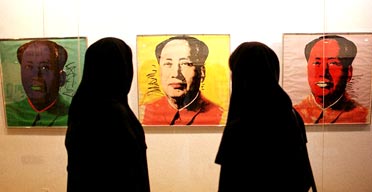Iran Feature: The Regime Casts Its Shadow Over Art (Genocchio)
 Tehran Museum of Contemporary ArtBenjamin Genocchio reports for The New York Times:
Tehran Museum of Contemporary ArtBenjamin Genocchio reports for The New York Times:
The paradoxes of Iran are visible at the Museum of Contemporary Art, designed by the Iranian artist and architect Kamran Diba as an inverted version of the Guggenheim Museum in New York.
In the central atrium hangs an Alexander Calder mobile bought for the museum’s inauguration, in 1977, two years before the Islamic Revolution. To the right is an untitled 1966 sculpture by Donald Judd consisting of a vertical array of nine panels of what the wall label describes as “galvanized iron” stacked from floor to ceiling.
The Judd, probably worth $5 million today, is just one of hundreds of Impressionist, modern, and contemporary artworks acquired at the institution’s founding. But it and the Calder are among the few Western pieces still on view; the rest, including works by Monet, Van Gogh, Pissarro, Renoir, Gauguin, Toulouse-Lautrec, Magritte, Miró, Braque and Pollock, are buried in storage. A close look at the Judd sculpture reveals scratches and solvent stains on several of the panels, which are spaced unevenly on the wall and fixed badly — some askew.
Until the revolution, Iran was among the most cultured, cosmopolitan countries in the region. It had a progressive movement in art and literature and a sophisticated film and television industry. The mostly Shiite Muslim population was pious but not fanatical.
“We used to drink in public and pray in private, but today we pray in public and drink in private,” said my guide, who has an engineering degree and whose job was to accompany me everywhere, reporting on my movements.
Having him around was a condition of my entry into a country where foreigners are largely unwanted and unwelcome. Officially, Iran reports that it receives around 10,000 tourists annually, a staggeringly low number considering its cultural attractions; Persepolis, capital of the Achaemenid Persian Empire, is one of the great archaeological sites in the region. Dubai, with little to offer beyond shopping and an annual art fair, gets about a million visitors a year.
These are anxious times for artists in Iran. Some have simply decided to remain outside the country.
In spring 2009, the brothers Ramin and Rokni Haerizadeh were en route to Tehran after a brief trip to Paris for their first show at Galerie Thaddaeus Ropac when, according to an interview published recently in Wmagazine, “they got a call from a friend warning them not to return home". Their work had been confiscated during a raid on the home of a Tehran collector, and it was feared that they would be arrested. The brothers applied for residency in the United Arab Emirates and now live in Dubai.
Culture is valued here. There are numerous public theaters, museums, galleries and both public and private art schools in Iran. The country annually turns out about 40,000 art-school graduates, including graphic artists. But since the end of Mohammad Khatami’s relatively liberal presidency in 2005, numerous artists, editors, writers, and filmmakers have been jailed.
According to Hamid Keshmirshekan, editor in chief of Art Tomorrow, a new Iranian contemporary art magazine, Tehran has more than 60 private galleries — 100 if you include all the “public” spaces — spread around the city but mostly clustered in the wealthier northern suburbs. Many are in private houses, so the scene has an ad hoc feel. A handful of private individuals back the arts. Most gallery owners are women, as they are elsewhere around the world.
In the course of my stay in Tehran, I visited about a dozen galleries, met many talented artists and saw daring and progressive work. The good news is that Iranian art is alive and well. The bad news is that so much of the work cannot be shown publicly, or can be exhibited only for a few hours during an opening before being whisked into storage.
The Ministry of Islamic Culture and Guidance keeps a tight rein on what can and cannot be displayed, and every gallery owner I met had a story about being called in to the ministry and asked to explain and subsequently remove the artworks on their walls. Pieces deemed offensive or blasphemous expose dealer and creator to prosecution.

 Friday, April 1, 2011 at 8:35
Friday, April 1, 2011 at 8:35
Reader Comments